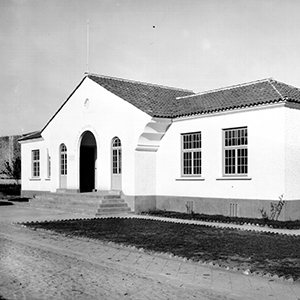The Department of Psychopedagogy and Hygiene and school spaces, an institutional approach. Mexico, 1924-1930
DOI:
https://doi.org/10.35305/23626097v7i13.274Keywords:
Secretary of Public Education, Department of Psychopedagogy and Hygiene, schools, school space, architectureAbstract
Based on official files from the Mexican Ministry of Public Education (SEP), this article analyzes how urban school spaces were redefined during the period of 1924-1930. The Department of Educational Psychology and Hygiene (DPeH), founded by the SEP in 1925, was the principal office dedicated to the inspection of hygiene in school spaces for students and the teaching staff. Influenced by the “school of action” and its precept learning by doing, required specifications (lighting and ventilation) for classrooms and workshops were enforced. Outdoor spaces for the development of sports activities were also needed for an adequate institutional functioning.
Downloads
Metrics
References
Bernal, M. y José, M. (2000). De las escuelas al aire libre a las aulas de la naturaleza. Áreas. Revista Internacional De Ciencias Sociales, (20), 171-182. Recuperado de https://revistas.um.es/areas/article/view/144721
Britton, J. A. (1972). Moisés Sáenz: Nacionalista mexicano. Historia Mexicana, 22(1), 78-98.
Carrillo, A.M. (1999). El inicio de la higiene escolar en México: Congreso Higiénico Pedagógico de 1882. Revista Mexicana de Pediatría, 66(2), 71-74.
Chaoul Pereyra, M. E. (2012). La higiene escolar en la ciudad de México en los inicios del siglo XX. Historia Mexicana, LXII(1), 249-304.
Domínguez M. C. (2010). Una antología de José Vasconcelos. CDMX: México, Fondo de Cultura Económica.
Fell, C. (2000). José Vasconcelos, Ulises criollo. Edición crítica. CDMX: México: Fondo de Cultura Económica.
Guichot, V. (2010). Bases pedagógicas de la escuela nueva. El progresismo de John Dewey. En C. Sanchidrián y J. R. Berrio (coords), Historia y perspectiva actual de la educación infantil (pp. 179-199). Barcelona, España: Graó.
Loyo, E. (1984). Lectura para el pueblo (1921-1940). Historia Mexicana, 33(3), 298-347.
Loyo, E. (1991). Escuelas rurales Artículo 123 (1917-1940). Historia Mexicana, XL(2), 299-336.
Luna, P. I. (2019). Una escuela puede transformar al país: Origen, desarrollo y consolidación de la política pública de infraestructura educativa en México. 1944-1964 (Tesis de Maestría). Universidad Nacional Autónoma de México, México.
Meneses, E. (1998). Tendencias educativas oficiales en México. México DF, México: Universidad Iberoamericana.
Meníndez, R. (2013). Las escuelas primarias de la ciudad de México en la modernidad porfiriana. México DF, México: Universidad Pedagógica Nacional.
Moreno, P. (2010). El método Decroly. En C. Sanchidrián y J. R. Berrio (coords). Historia y perspectiva actual de la educación infantil (pp. 225- 243). Barcelona, España: Graó.
Meyer, Jean. (1992). México: Revolución y reconstrucción en los años veinte. En Bethel, L. Historia de América Latina, vol. 9, México América Central y el Caribe, c. 1870-1930, (pp.146-180). Barcelona, España: Crítica-Cambridge University Press.
Ortega, C. (2012). Ciencia y revolución en la arquitectura escolar. Ciudad de México (1910-1920). Ciencia y Desarrollo, 38 (259), 39-42. Recuperado de https://cyd.conacyt.gob.mx/archivo/259/articulos/ciencia-y-arquitectura.html
Ortega, C. (2014). Arquitectura escolar en la ciudad de México, 1880-1920 (Tesis doctoral). Universidad Nacional Autónoma de México, México.
Ortega, C. (2015). Historia Política de la Tecnología: una propuesta metodológica para la historia de la arquitectura escolar (Ciudad de México, 1880-1921). Revista Mexicana de Historia de la Educación, III(6), 159-180.
Santa Ana, L.G (2007). Arquitectura escolar revolucionaria: de la Constitución a la construcción de Ciudad Universitaria (Tesis de doctoral). Universidad Nacional Autónoma de México, México.
Schávelzon D. (1983). Vicente Mendiola = Escuelas al aire libre (1926-1927). Traza. Temas de arquitectura y Urbanismo, (5), 3.
Staples, A. (2008). Primeros pasos de la higiene escolar decimonónica. En C. Agostoni (coord.), Curar, sanar y educar. Enfermedad y sociedad en México, siglos XIX y XX, (pp. 17-42). México DF, México: UNAM-BUAP.
Vasconcelos, J. (2011). Obras Completas. México DF, México: Fondo de Cultura Económica Academia Mexicana de la Lengua. Recuperado de http://www.academia.org.mx/academicos-1934/item/jose-manuel-puig-casauranc.
Memorias SEP, 1927-1930. Fondo Antiguo, Universidad Pedagógica Nacional. México, D.F.
[Fotografía de construcción de la escuela al aire libre, Tamaulipas, México 1924-1928]. (Ca. 1928). Archivo Casasola, Fototeca Nacional de México. Recuperado de: https://mediateca.inah.gob.mx/islandora_74/islandora/object/fotografia%3A102800
[Fotografía de escuela Álvaro Obregón, exterior, vista parcial, Ciudad de México, Distrito Federal, México]. (Ca. 1928). Archivo Casasola, Fototeca Nacional. Recuperado de: https://mediateca.inah.gob.mx/islandora_74/islandora/object/fotografia%3A3468
Quintanilla, C. (1922, noviembre 30) Datos para crecimiento del niño mexicano. [Manuscrito]. 23-1-4-42 III 342/2. Archivo Histórico Secretaría de Educación Pública, México.

Published
How to Cite
Issue
Section
License
Open access policy
A&P Continuidad is a non-profit and open access publication. According to Mexico Declaration on Cultural Policies, the journal distribution is submitted to Creative Commons Attribution-Noncommercial-ShareAlike 4.0 International Public License (CC BY-NC-SA). “Neither the commercial use of the original work nor that of the possible derivative works are allowed. The distribution of derivative works should be submitted to the license regulating the original work. This license is not free.”
A&P Continuidad authorizes the partial or full reproduction of texts and graphs provided that the source is cited. Authors are exclusively responsible for the criteria expressed in the articles which do not necessarily reflect the opinion of the Editorial Committee or that of the Direction Board. The copyright of the published articles pertains to their authors or publishers.
Transfer of rights
The acceptance of an article to be published implies the author’s transfer of rights to the journal. Authors continue to have the right to use the material in future books or publications, approve or veto the republication of their works as well as the rights related to patents or other rights. Transfer of rights form may be downloaded here.























 This OJS site and its metadata are under a
This OJS site and its metadata are under a 

